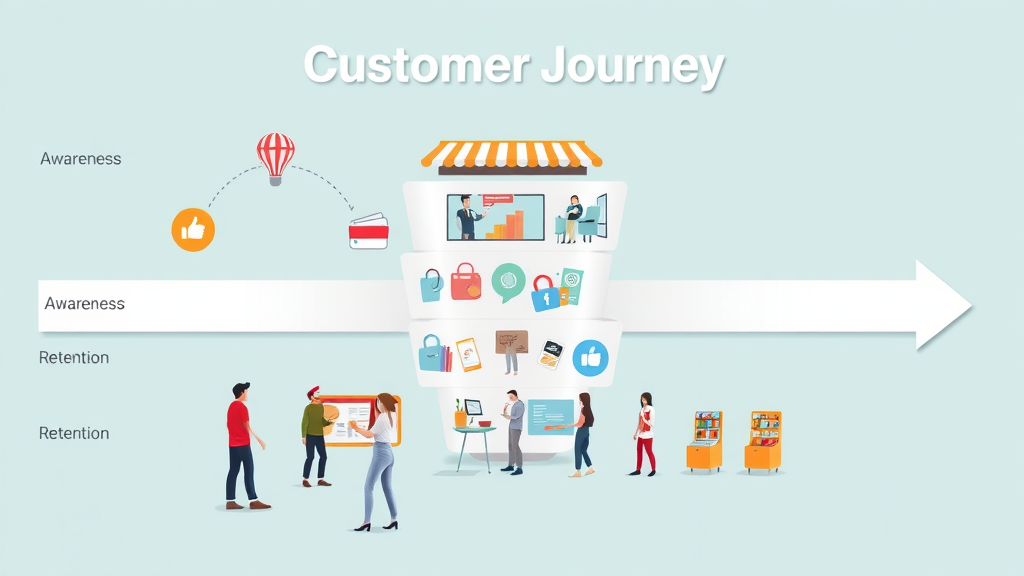Customer Acquisition for Local Businesses: Stop Losing Clients!

Did you know that nearly 70% of local businesses lose more customers each year than they gain? In today’s fiercely competitive digital landscape, mastering customer acquisition for local businesses can mean the difference between growth and closure. If you’re tired of watching competitors snatch your clients, this all-in-one guide will reveal exactly how you can reverse your fortunes, build a loyal customer base, and grow your small business for the long term.
Get ready to uncover industry secrets, practical tips, and growth tactics designed specifically for local shops, service providers, and small businesses just like yours!
Why Customer Acquisition for Local Businesses Matters in 2024
- According to recent studies, local businesses are experiencing churn rates higher than 30% annually . This means your efforts to get new customers are required just to stay even, let alone grow.
- Effective customer acquisition strategies are now mission-critical—not just for filling your sales funnel, but also for reducing your acquisition cost, outmaneuvering online giants, and sustaining your bottom line.
- Small businesses that prioritize structured customer acquisition are 2.5x more likely to see revenue growth, customer retention, and long-term stability compared to those who rely on word-of-mouth alone.

Unlocking Success: The Fundamentals of Customer Acquisition for Local Businesses
- Customer acquisition for local businesses means attracting, engaging, and converting potential customers in your geographic area into paying, loyal clients.
- Focusing on local lead gen helps you stand out in your neighborhood, where personal reputation and in-person experience still matter.
- A strategic approach enhances business growth—when you invest in the right acquisition strategies, your entire customer base and business value increase.
- On average, the customer acquisition cost (CAC) for local businesses ranges from $20 to $150 per customer, depending on industry and channel.
- Recent trends show digital tactics—like social media and hyperlocal ads—can lower your cost-per-acquisition by up to 40%.
- Businesses that implement a targeted customer acquisition strategy are not only cutting costs, but are seeing increased customer retention and engagement.
What You’ll Gain from This Guide on Customer Acquisition for Local Businesses
- Step-by-step customer acquisition strategies you can implement right away
- Real local business examples and success stories
- Exclusive tips to drive down your acquisition cost without sacrificing quality
- Methods to grow and engage a loyal customer base that supports your long-term growth

Understanding the Customer Acquisition Process: From Lead Generation to Loyal Customer
Mapping the Customer Journey: Local Business Perspective
- The customer acquisition funnel for small businesses typically has five crucial stages: awareness, interest, consideration, purchase, and retention . For example, a local bakery might first introduce itself through a flyer (awareness), then offer free samples (interest), provide testimonials or reviews (consideration), secure a purchase, and finally invite customers back with a loyalty card (retention).
- Each stage plays a role in driving customer engagement . By mapping how a potential customer navigates your sales funnel, you can spot weaknesses—maybe prospects stall at the ‘interest’ stage or never return after purchase.
- Effective customer acquisition means optimizing every touchpoint—digital or physical—so that more leads become loyal customers.

Key Touchpoints for Effective Customer Acquisition in Small Businesses
- Your customer acquisition strategy must integrate both online and offline lead gen : websites, Google My Business profiles, walk-in traffic, phone calls, and face-to-face events all have a place in your funnel.
- Local businesses increasingly rely on social media engagement—answering questions, showcasing products, and running contests—to boost visibility and nurture relationships.
- In every interaction—from first website visit to in-store purchases—measure how each channel contributes to lead generation and customer retention.
Identifying and Segmenting Your Target Audience for Customer Acquisition
Gathering Insights: Researching Potential Customers
- Use local market research tools: survey local residents, analyze competitor reviews, monitor trending searches, and leverage social listening to understand the needs of your target audience .
- Collect direct feedback from existing customers about what drew them in and what could improve their experiences. These insights fuel both lead gen and retention.
- Define the core customer profile by outlining age, preferences, typical spend, and lifestyle. This guides every aspect of your marketing efforts.

Creating Buyer Personas for Local Customer Acquisition
- Develop clear, realistic buyer personas using demographic data (age, family status), geographic factors (zip code, proximity), and psychographics (interests, values, pain points).
- These personas become the foundation of your effective customer acquisition strategy—shaping messaging, promotions, and even service hours.
- Test and update personas regularly by tracking which segments have the highest customer lifetime value and engagement.
Choosing the Right Customer Acquisition Strategy for Small Business Success
Top Customer Acquisition Strategies Local Businesses Trust
- In-store promotions and loyalty discounts
- Referral programs that reward your existing customer base for bringing in new clients
- Partnerships with other neighborhood businesses for joint promotions
- Hyperlocal digital ads (especially on Google or Facebook with geotargeting)
- Consistent digital acquisition strategies : content marketing, search engine optimization, and targeted emails

Aligning Acquisition Strategies with Your Business Goals
- Tailor your customer acquisition strategies to your specific business objectives. Want more walk-ins? Invest in local event sponsorships. Need to build awareness? Start with digital ads and content marketing.
- Combine multiple channels for maximum effect. For example, offer an in-store promo code that’s advertised on your social media, then measure which channel sends more new customers.
- Test and adjust: Regularly review what’s working with your target audience and cut what isn’t. Data-driven shifts can drop your acquisition cost significantly over time.
Cost-Effective Customer Acquisition for Local Businesses: Lowering Your Acquisition Cost
Calculating Customer Acquisition Cost for Small Businesses: Practical Examples
- Formula: Customer Acquisition Cost (CAC) = Total Marketing & Sales Expenses ÷ Number of New Customers Acquired.
- For example, if your small business spends $2,000 monthly on ads, events, and sales staff—and gains 20 customers—your CAC is $100. If you reduce digital ad spend and boost referrals, that cost could drop to $65 or less.
- Understanding and tracking your CAC lets you set realistic budgets, measure ROI, and plan scaling strategies.
Tips to Minimize Acquisition Cost Without Losing Quality
- Shift budget toward organic channels —SEO-optimized blog posts or social media groups reach your target audience with lower spending.
- Activate loyal customer advocacy: Offer referral perks and highlight customer testimonials for increased trust.
- Routinely audit your marketing efforts, focus on channels delivering the best lead gen , and refine your offers to maximize conversion rates and long-term value.
| Channel | Average CAC | Pros | Cons |
|---|---|---|---|
| PPC Ads | $100–$300 | Immediate traffic, high intent | Expensive, only as good as budget allows |
| Social Media Ads | $50–$120 | Targeted local reach, brand building | Requires ongoing optimization |
| Organic Social Media | $20–$60 | Builds community, sustainable traffic | Slower results, requires consistency |
| SEO/Content Marketing | $25–$80 | Long-term lead generation , credibility | Time investment, delayed ROI |
| Referral Programs | $10–$50 | Low CAC, increased trust | Depends on engaged customer base |
Harnessing Digital Channels: Social Media, Content Marketing, and Email for Customer Acquisition
Social Media Strategies to Boost Local Customer Acquisition
- Use Facebook to run neighborhood specials, respond swiftly to inquiries, and build community groups focused on your product or service.
- Post visually rich content and interactive stories on Instagram —showcase local events, customer shoutouts, and behind-the-scenes looks.
- Keep your Google My Business profile up-to-date with promotions, photos, and responses to reviews. It’s often your first impression!

Content Marketing & Lead Gen: Driving Qualified Leads
- Create blog posts on neighborhood topics, service guides, or “local’s choice” lists, all optimized for search engines to capture local traffic.
- Offer downloadable coupons, how-to guides, or enter-to-win contests—these lead generation magnets bring qualified potential customers onto your email list.
- Regular newsletters keep your business top of mind and nurture leads through their journey.
Crafting Effective Email Marketing Campaigns for Small Businesses
- Segment your email lists—separate recent buyers from long-term customers to deliver more relevant promotions and content.
- Use automation to send welcome messages, birthday discounts, or reminders about abandoned carts or online forms.
- Track open rates and response to continually improve your email marketing effectiveness.
- Watch our embedded video to access actionable tips from industry experts who’ve helped dozens of small businesses supercharge their customer acquisition and retention.
Building Customer Relationships and Driving Retention for Small Businesses
Transforming First-Time Buyers into Loyal Customers
- Use robust customer relationship management: Reach out after purchases, ask for reviews, and offer ‘next visit’ discount cards.
- Launch a loyalty program that offers points, rewards, or VIP perks—and make sure regulars feel seen and appreciated.
- Focus on after-sales service: Be prompt, helpful, and genuine. Exceptional customer experience is the foundation of customer retention .

Improving Customer Experience at Every Touchpoint
- Personalize your interactions—remember names, favorite products, or previous requests.
- Close the feedback loop: Encourage reviews or suggestions and act on them so your customer base knows you’re always improving.
- The customer experience is not just one moment—it’s every email, every phone call, every smile at the door.
Data-Driven Decision Making: Measure, Analyze, and Optimize Customer Acquisition
Tracking Acquisition Metrics that Matter
- Monitor core KPIs: Conversion rates (lead to customer), customer lifetime value (total spend over relationship), and customer acquisition cost (total spend per new customer).
- Use dashboards and reporting tools to spot trends and make faster, more confident decisions in your customer acquisition strategy.
- Regular tracking of these metrics keeps your team focused on what drives real growth—not just vanity numbers.

Using Analytics to Refine Customer Acquisition Strategy for Small Businesses
- Translate insights into action: If Instagram reels get more clicks than Facebook posts, double down on that format.
- Implement A/B testing —try different headlines or offer types and see what gets your audience excited.
- Continue reviewing which customer segments cost the least to acquire but have the highest customer lifetime value.
| Metric | Definition | Why It Matters |
|---|---|---|
| Customer Acquisition Cost (CAC) | Total spend per acquired customer | Optimize budget, reduce waste |
| Customer Lifetime Value (CLV) | Total profit from each customer | Measure long term customer value |
| Conversion Rate | Leads converted to buyers (%) | Spot effectiveness of each channel |
| Retention Rate | % of repeat buyers over time | Track quality of customer experience |
- This step-by-step video walkthrough demonstrates exactly how small businesses can lower their CAC while still scaling up their customer acquisition strategies .
Case Studies: Winning Customer Acquisition Strategies for Local Business
Small Business Success Stories
- Ella’s Florist: By running hyperlocal Facebook and Instagram ads tied to seasonal events, Ella cut her acquisition cost by 42% and saw a 60% bump in new loyal customer sign-ups in 6 months.
- Rex’s Gym: Rex implemented a robust referral program and automated email marketing to bring in 100+ new members with a CAC below $30—down from an average of $80.
- The Book Nook: By mapping the customer journey and improving in-store customer experience through staff personalization, the shop doubled its rate of repeat buyers and increased customer lifetime value.

Lessons Learned: What Made These Customer Acquisition Strategies Work?
These mini-case studies show the value of aligning acquisition strategy with local realities , leveraging data, nurturing a true community around the brand, and investing in both digital and physical touchpoints.
The most successful small businesses never stop testing and adapting their acquisition approaches based on what real customers want.
By analyzing their results, each business found the optimal blend of customer engagement , efficient spend, and personal service—key drivers in building a loyal customer base.
Troubleshooting Common Customer Acquisition Challenges for Local Businesses
- Budget Constraints: Solution—Start with organic content marketing (blogging, local SEO), and gradually reinvest early returns into paid lead gen campaigns.
- Poor Targeting: Solution—Review buyer personas and use social media’s targeting features to zero in on your target audience .
- Ineffective Channels: Solution—Use analytics to assess the ROI of every channel, then shift spend to the most effective customer acquisition strategies.

Quote
“Effective customer acquisition for local businesses isn’t about chasing every trend. It’s about building real connections with your community, measuring what works, and never losing sight of the customer experience.”
- Enjoy a Q&A with leading marketing professionals, answering real-world questions and providing clarity on how to succeed at customer acquisition for local businesses .
Top 10 Customer Acquisition Tips for Local Businesses
- Build and verify your Google My Business profile for top local search engine visibility
- Launch a customer referral program with genuine rewards
- Leverage social media engagement to showcase local events and customer stories
- Offer exclusive, in-store promotions or loyalty cards
- Invest in hyperlocal digital ads targeting your neighborhood
- Publish regular, SEO-friendly blog posts about your area
- Segment email lists to send relevant updates and offers
- Collaborate with other small businesses for joint promotions
- Collect direct feedback and reviews from every customer
- Track and adjust your customer acquisition cost for each campaign—always know your numbers!
People Also Ask: Essential Customer Acquisition Questions for Local Businesses
[[paa_q1]]
- An effective customer acquisition strategy for local businesses involves a combination of online visibility, personalized service, and ongoing engagement. Start by identifying where your target audience discovers new local brands and tailor your approach to reach them at every stage—from discovery to purchase.
[[paa_q2]]
- To improve customer acquisition for local businesses , focus on a mix of digital and traditional methods: optimize your web presence, make use of social media , and encourage word-of-mouth through satisfied regulars.
[[paa_q3]]
- The most successful customer acquisition strategy addresses your best customers directly. Prioritize value, trust, and relevance in all lead gen activities—monitor your results closely to fine-tune your campaign mix.
[[paa_q4]]
- Customer acquisition cost is the total you spend to gain a new client, including marketing and sales costs. Use this metric to assess the efficiency of your acquisition strategies and ensure you’re growing your business profitably.
FAQs About Customer Acquisition for Local Businesses
- What is the average customer acquisition cost for small businesses? It ranges from $20–$150, depending on your industry, location, and marketing channels.
- Why is customer acquisition important? It grows your customer base , stabilizes revenue, and counters customer churn.
- What are effective strategies for local customer acquisition? Local SEO, referral programs, targeted ads, and community engagement top the list.
- How do you retain customers after acquisition? Focus on an exceptional customer experience with follow-up, loyalty programs, and personalized offers.
Summary: Mastering Customer Acquisition for Local Businesses—Take Action Now
- Understanding and investing in the right customer acquisition strategies is the foundation for small business survival and success. Strategize, personalize, measure, and keep improving—your business’s growth starts here. Begin today, and transform your customer base—one loyal relationship at a time!
To enhance your understanding of effective customer acquisition strategies for local businesses, consider exploring the following resources:
- “8 Customer Acquisition Strategies for Small Businesses” ( welcomewagon.com )
This article outlines practical methods such as leveraging local SEO, developing referral programs, and utilizing social media advertising to attract and convert new clients without significant financial investment.
- “9 Best Customer Acquisition Strategies That Maximize ROI” ( appnova.com )
This resource delves into strategies like content marketing, loyalty programs, and influencer partnerships, providing insights on how to implement these approaches to achieve maximum return on investment.
By reviewing these articles, you’ll gain actionable insights and proven tactics to effectively acquire and retain customers for your local business.





